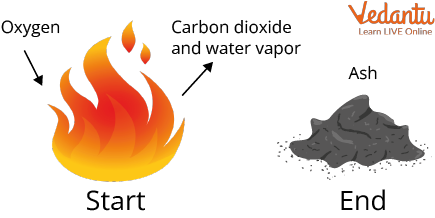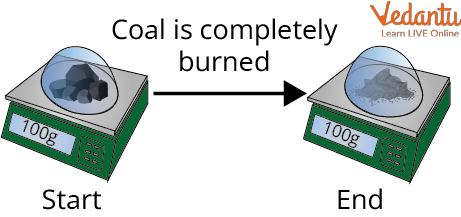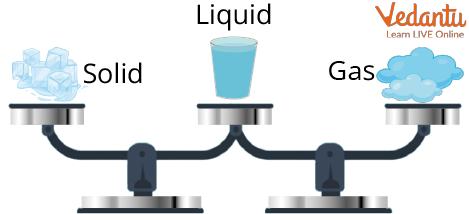




An Introduction to Law of Conservation
The law of conservation of matter says that the amount of matter remains the same, in any event, when matter changes form. Sometimes it might appear to be that matter vanishes during a science experiment; however, this law lets us know that matter can't mystically appear or vanish; it just changes from one form to another. One more method for making sense of the law of conservation of matter is to express that things can't be magically destroyed. In short, “The mass in an isolated system can neither be created nor be destroyed, but it can be transferred from one form to another”.

Fire and Ash
What is the Law of Conservation of Matter?
The law of conservation of mass or principle of mass conservation expresses that for any system close to all transfers of matter and energy, the mass of the system should stay consistent over time, as system mass can't change the amount if it is not added or removed. Subsequently, the amount of mass is "conserved" over time. This law states that mass can neither be created nor be destroyed, although it might be rearranged in space, or the substances related to it could be changed in form, for example when light or physical work is changed into particles that contribute a similar mass to the system as the light or work had contributed.

The Weight of Coal Remains the Same Even After Burning
Fire is which State of Matter?
Burning might destroy matter, but the same amount, or mass, of matter, actually exists after a campfire as before. It's like when wood burns, it combines with oxygen and changes not only to ashes but also to carbon dioxide and water vapour. The gases float off high in the air, leaving only the ashes. While there is some ionisation in a typical fire, the majority of the substance in the flame is a gas. As a result, the safest response to the question "Fire is which State of Matter?" is that it is a gas. Or, to put it another way, it's primarily gas with a minor quantity of plasma.
What are the Examples of the Law of Conservation of Matter?
The law of conservation of matter examples include:
Combustion Process: The burning of wood is a conservation of mass as the burning of wood includes oxygen, carbon dioxide, water vapours, and ashes.
Chemical Reactions: To get one molecule of H2O (water) with the weight of 10, hydrogen with molecular weight 2 is added with oxygen whose molecular weight is 8, in this way conserving the mass.
What is Conversion of Matter?
Conversion of matter refers to the change from one state of matter to another. It is a cycle by which matter changes starting with one state then onto the next and back to its original state, with no adjustment of its chemical composition. Solid can be converted into fluids by heating. Essentially, fluids can be converted into gases by heating and gases can be converted into fluid and fluids can be converted into solids by cooling. The conversion of states is a physical change because these changes happen without a change of composition and no change in the chemical nature of the substance.
Solid to Liquid: Melting
Liquid to Gas: Evaporation
Gas to Liquid: Condensation
Liquid to Solid: Freezing
Solid to Gas: Sublimation
Gas to Solid: Deposition

Weight Remains the Same in any Form
Summary
In this article, we learnt about the law of conservation of matter by observing our day-to-day life examples like burning and different changes in the matter do not destroy matter. The mass of matter is consistently the same before and when the changes happen. The law of conservation of mass expresses that matter cannot be created or destroyed.
FAQs on Law of Conservation of Matter - Science for Kids
1. If energy is neither created nor destroyed, what is the ultimate source of energy?
The ultimate source of energy in our current universe is the Big Bang. All the energy was created at the beginning of time and as the universe grew a few phases of particulate matter were created, produced from that energy. By the time of the Modern Universe, the energy was distributed either into mass, kinetic energy, chemical energy in chunks of matter, or radiant energy. The majority are ordered into galaxies and stars inside them. The sun is one of those stars and got its energy from the early stage Big Bang.
2. What are the implications of the law of conservation of matter?
The implications of this law are quite large. To start with, the law considers any chemical reactions to be completely understood and completely measured. The law, thus, allows scientists to predict the mass of the products in a chemical reaction. This can be fundamental in various circumstances. Rocket fuel, for example, is specifically formulated with the right proportion of kerosene and liquid oxygen so it burns completely and totally. Knowing the mass of the two products being burned allows scientists to predict precisely how carbon dioxide and water vapour will be created. From that point, scientists can estimate the mass and velocity of the exhaust gases and predict how much thrust a rocket engine will provide.
3. Is matter created or destroyed?
By definition, mass is conserved during a chemical change – no matter is created or destroyed but the matter is rearranged into new structures with different properties. Energy is stored in the bonds between atoms, however, so energy can be released or converted during a chemical change.









